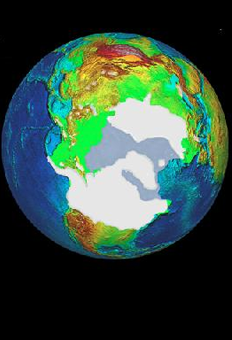NOAA/WDS Paleoclimatology - Temperate Western North America 1500-1980 AD February-March 2m Air Temperature
This archived Paleoclimatology Study is available from the NOAA National Centers for Environmental Information (NCEI), under the World Data Service (WDS) for Paleoclimatology. The associated NCEI study type is Climate Reconstruction. The data include parameters of climate reconstructions|tree ring with a geographic location of North America. The time period coverage is from 450 to -30 in calendar years before present (BP). See metadata information for parameter and study location details. Please cite this study when using the data.
Dataset Citation
- Cite as: Wahl, E.R.; Diaz, H.F.; Smerdon, J.E.; Ammann, C.M. (2014-09-02): NOAA/WDS Paleoclimatology - Temperate Western North America 1500-1980 AD February-March 2m Air Temperature. [indicate subset used]. NOAA National Centers for Environmental Information. https://doi.org/10.25921/186r-cc58. Accessed [date].
- Please refer to Credit tab for full citation information.
Dataset Identifiers
- doi:10.25921/186r-cc58
- noaa-recon-17157
- NCEI DSI 1200_02
- NCEI DSI 1200_01
ISO 19115-2 Metadata
noaa-recon-17157
| Search Data |
|
| Download Data |
|
| Distribution Formats |
|
| Ordering Instructions | Contact NCEI for other distribution options and instructions. |
| Distributor |
NOAA National Centers for Environmental Information ncei.info@noaa.gov |
| Dataset Point of Contact |
NOAA National Centers for Environmental Information ncei.info@noaa.gov |
| Dataset Point of Contact | Data Center Contact NOAA World Data Service for Paleoclimatology 828-271-4800 paleo@noaa.gov |
| Coverage Description | Date Range: 1500 CE to 1980 CE; Date Range: 450 cal yr BP to -30 cal yr BP; |
| Time Period | 1500 to 1980 |
| Spatial Bounding Box Coordinates |
West: -130
East: -95
South: 30
North: 55
|
| Spatial Coverage Map |
| General Documentation |
|
| Associated Resources |
|
| Publication Dates |
|
| Data Presentation Form | Digital table - digital representation of facts or figures systematically displayed, especially in columns |
| Dataset Progress Status | Complete - production of the data has been completed |
| Data Update Frequency | Data update frequency not available |
| Supplemental Information | ABSTRACT SUPPLIED BY ORIGINATOR: February-March temperature reconstructions in western North America from 1500-1980 in the Common Era (CE) are used to evaluate, from a regional perspective, the hypothesis that radiative forcing by large tropical volcanic eruptions induces a tendency in the climate system towards an early post-event El Niño (EN) response followed by a delayed La Niña (LN) response. Post-event spatial composites using superposed epoch analysis (SEA) detect indications for an EN-like pattern in post-event Years 1-2; this result, however, is sensitive to the set of eruptions evaluated. Highly significant LN-like patterns are also observed for two eruptions during Year 1. In contrast, a clear and unique LN-like response is found in both evaluated eruption sets during Years 3-5; Year 3 in particular represents the time of strongest post-event response. No significant EN-like patterns occur during these years. The relative homogeneity of the SEA response for each post-event year is evaluated in terms of the ratio of the amplitude of the SEA composite to its standard deviation across the eruption events. In relation to the same metric determined from random-event-year SEAs, these signal-to-noise ratios are most highly significant in the portions of the domain with the strongest anomalies in Years 1-5, especially Year 3. The signal-to-noise ratios tend towards uniformly low and insignificant values beyond the first half-decade after the eruption, indicating generally reduced coherence across events. In relation to the larger-scale circulation, post-eruption 500 mb February-March geopotential height composites from the 20th Century Reanalysis show ENSO-type features that are largely consistent with the SEA results from the primary eruption set during Year 1, but are inconsistent with the EN-like pattern exhibited by the second eruption set during Years 1-2. In Year 3, the pressure composite over North America and the adjacent Pacific and Atlantic is strongly LN-like, consistent with all SEA results; similarly, weakening coherence across events as time progresses beyond Year 3 is also consistent with more variable pressure composites noted after that time. The relatively robust character of the delayed LN-like response is evaluated in terms of the dynamic rebound of the climate system towards its initial energy balance as the radiative impact of immediate post-eruption aerosol cooling dissipates. The LN-like SEA temperature response in Years 3-5 exhibits a slight shift of its southern warm anomaly to the north and west relative to pure composite LN conditions, which is detected as a specifically post-eruption feature in the region. |
| Purpose | Records of past temperature, precipitation, and other climate variables derived from paleoclimate proxies. Parameter keywords describe what was measured in this data set. Additional summary information can be found in the abstracts of papers listed in the data set citations. |
| Dataset Citation |
|
| Cited Authors |
|
| Originators |
|
| Publishers |
|
| Theme keywords |
Global Change Master Directory (GCMD) Science Keywords
|
| Data Center keywords |
Global Change Master Directory (GCMD) Data Center Keywords
|
| Place keywords |
|
| Use Constraints |
|
| Access Constraints |
|
| Fees |
|
Last Modified: 2024-03-11
For questions about the information on this page, please email: ncei.info@noaa.gov
For questions about the information on this page, please email: ncei.info@noaa.gov

